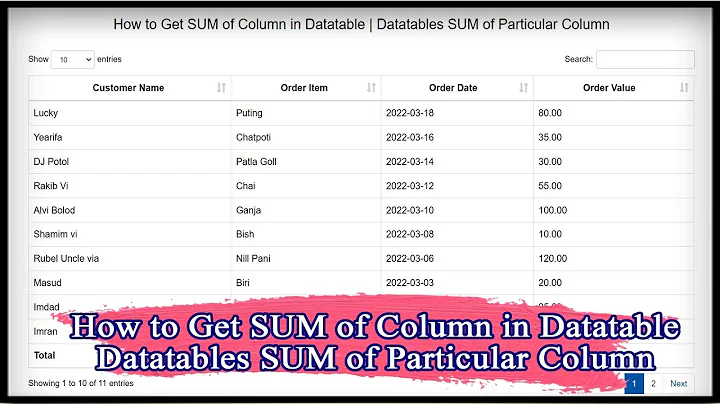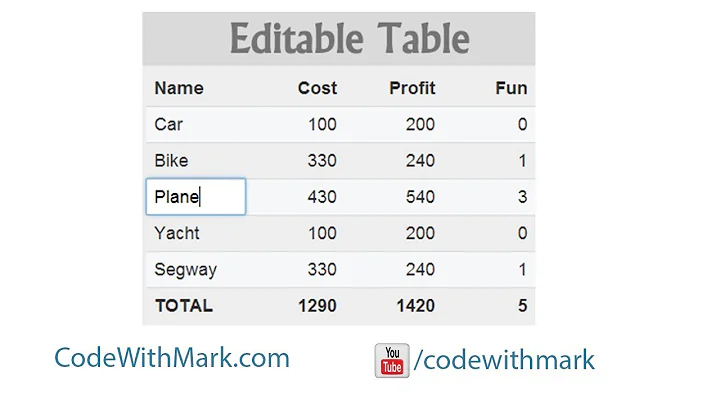Get Datatables cell value that is input text field
If you just want to extract the values entered in the input boxes, you must go through jQuery or native DOM. dataTables itself is not aware of any changes made to form input fields, so trying to retrieve the values by cell().data() will never work, with or without id's / orthogonal data :
aTable.cell(0,2).nodes().to$().find('input').val()
aTable.cell(0,3).nodes().to$().find('input').val()
Will give you the current value of the various inputs. Have replicated your above scenario 100% in this fiddle -> http://jsfiddle.net/obmghyo7/
This is basically also how the official documentation suggests a way to extract values from form inputs -> https://datatables.net/examples/api/form.html
If you want to perform filtering / searches within the table, which also includes changes made by the user in form inputs, then it is a little more tricky -> JQuery Datatables search within input and select (mine, but I dont know any better answer)
Related videos on Youtube
K Jackson
Updated on July 09, 2022Comments
-
K Jackson almost 2 years
I'm generating a DataTable with a javascript data source. The data is returned from an ajax call to nodejs which queries SQL Server DB table and returns 2 columns, both numerical data. I'm adding 2 more columns to hold input fields, with default value of 0, for the user to enter numbers that will increase/decrease the values found in ColumnA/B.
$('#mytable').DataTable( { "data": data, "columns": [ { "data": "ColumnA", "defaultContent": "NA" }, { "data": "ColumnB", "defaultContent": "NA" }, { "data": undefined, "defaultContent": '<input type="text" value="0" size="10"/>'}, { "data": undefined, "defaultContent": '<input type="text" value="0" size="10"/>'} ] });This renders just fine and I can modify the text in the input field in the cell. There is a separate input field outside the table that the user can click to 'submit changes', which calls a javascript function that will read those input fields of the table. However, I cannot figure out how to get them. Using:
var aTable = $('#mytable').DataTable(); var colAchange = atable.cell(0, 2).data(); var colBchange = atable.cell(0, 3).data();Both colA/Bchange vars just have the 'input type="text" ...' html text, not the value of the input field. This does make sense, but I cannot find the right way to read the value of the input field. At one time I had read in the Datatables docs that you can add 'meta' data to the row data. Do I need to do that to get an "id" on that element and query the element by that? Otherwise how do I get that input's value?
-
Bindrid about 7 yearsyou cannot use the .data function to read the input boxes if that is what you are trying to do.'
-
-
Bindrid about 7 yearsWhat davidkonrad said. But here is another example jsbin.com/viqafe/edit?js,output In this one, I copy the value in the textbox and added it to the associated column.
-
K Jackson about 7 yearsI tried to follow the doc example for form data, but could not figure it out; that's quite a jump from "var data = table.$('input, select').serialize();" to what you provided. I had a (DOM) solution with just normal html tables: "colAchange = aTable.rows[0].cells[2].firstChild.value;" but trying to get that into a 'Datatables' reference isn't clear in the docs. Answer works perfect, appreciate the clarification.
-
K Jackson about 7 yearsReviewing the docs further, I found the .nodes() reference, but where is the information about .to$() ? I'm not sure what that is doing 'to' the node(s).
-
 davidkonrad about 7 years@KJackson datatables.net/reference/api/to%24() is the same as datatables.net/reference/api/toJQuery() and it only works on
davidkonrad about 7 years@KJackson datatables.net/reference/api/to%24() is the same as datatables.net/reference/api/toJQuery() and it only works onnodes()notnode()[which to me is a lack in dataTables]to$()just return the DOM node as a jQuery instance, so you easier can operate on the DOM. It is more easy to use.find()than starting to usequerySelector()..if.. and so on. Hope it helps.

![How To Display Selected HTML Table Row Values Into Input Text Using JavaScript [ with Source code ]](https://i.ytimg.com/vi/T3_-I_mPF-U/hq720.jpg?sqp=-oaymwEcCNAFEJQDSFXyq4qpAw4IARUAAIhCGAFwAcABBg==&rs=AOn4CLDSDUAmwkWhfZpGjf_ZO8ajnQhdZQ)
![Searching/filtering a Datatable in [React] (React Hooks Api, React Datatables, JavaScript Fetch API)](https://i.ytimg.com/vi/d1r0aK5awWk/hq720.jpg?sqp=-oaymwEcCNAFEJQDSFXyq4qpAw4IARUAAIhCGAFwAcABBg==&rs=AOn4CLCE4Ss4-xxbRMJw4RcTadEo2BgTXA)



![jQuery Get Table Cell Value TD Value [4 ways]](https://i.ytimg.com/vi/v22AyizvItI/hqdefault.jpg?sqp=-oaymwEcCOADEI4CSFXyq4qpAw4IARUAAIhCGAFwAcABBg==&rs=AOn4CLCNB2yDOaApXgHe9aSM76YUvNOskw)
